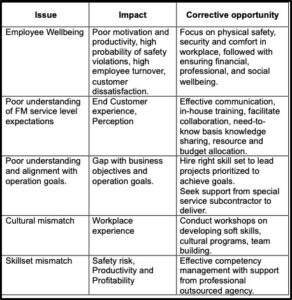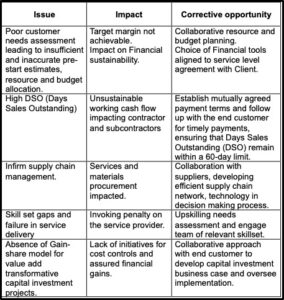Facility Management Services – People, Performance and Profit
People

Let’s not turn our Operations Manager into a Scapegoat!
Personnel on-site are pivotal to the success of a Facility Management Operation. Consequently, the estimation related to the Project or Operation Pre-Start phase is of the utmost importance for precisely aligning with and satisfying client needs and expectations. In the case of a typical Facilities Management Short Contract or Subcontract, personnel onboarding represents the most significant portion of the operations budget allocation.
Through the commencement of the bidding procedure, the principal contractor and its subcontractors are required to partake in crucial phases of:
- Preliminary information gathering.
- Comprehension of objectives and goals set out by the client business.
- Conducting a preliminary needs assessment and comprehensive risk analysis.
- Meeting in person with key stakeholders and decision-makers assessing stated and unstated expectations from service team members.
- Gauge a fair understanding of critical financial and non-financial influencing factors for successful contract management.
Recruiting and integrating personnel of appropriate skill sets presents a considerable challenge due to the accompanying cultural adjustments, scarcity of talent in local areas, and financial constraints. Considering the operations needs and factors influencing operations workflow, it is incumbent upon the Principal Contractor and Subcontractor to follow through:
- Careful mapping of roles and responsibilities of each personnel onboarded on-site.
- Develop a skillset matrix to serve the Facility and explore gaps and needs for upskilling.
- Establish and engage in-house and outsourced specialised upskilling agencies.
- Establish adequate measures for workplace experience for each member on the job.
- Foster a culture of multi-tasking and ownership of assigned service portfolios.
Performance

Facility service operators’ performance is primarily divided into hard and soft services. Within these categories, the alignment and any perceived or measurable gaps with the client organisation’s needs and expectations influence the service provider’s effectiveness.
Soft Service Performance –
The management of soft services performance largely relies on the efficiency of functional processes. This results in tangible and intangible benefits for end customers and fosters positive perceptions. The ground service delivery team must be aware of the cultural dynamics of the customer’s workplace, including ergonomics, etiquette, and overall effectiveness. Performance metrics in operations soft skills must include a minimum of the following attributes.
- Communication skill
- Job-fit professional appearance
- Awareness of local cultures and adaptability in multi-cultural, diverse age and gender group teams.
- Conscious ethical conduct
- Mutual respect and inclusive teamwork culture
Hard Service Performance –
Performance management tools for hard services fundamentally depend on trade-specific knowledge and experience, complemented by efficient measurement, monitoring, and traceability instruments utilised within facility services. The performance management metrics must lead to the development of cognitive skills of the blue-collar team members. Value addition objectives-based Performance metrics must foster initiatives and transformative efforts towards sustainability.
Key Performance Indicators –
The Key Performance Indicators (KPIs) formulated for site-specific operations must encompass a diverse array of service portfolios across the Strategic, Tactical, and Operational domains. These KPIs should advocate for sustainability within the parameters defined by customer-centric business objectives. Broadly, the KPIS can be categorised into ‘Leading’ and ‘Lagging’ indicators, which evaluate, plan, and prioritise service improvement initiatives. Digitised monitoring, tracking, and recording of critical activities significantly enhance the credibility of the Performance Management framework.
“Profit in business comes from repeat customers, customers that boast about your project or service, and that bring friends with them.” – W. Edwards Deming
Profits

The profitability of Facility Services is contingent upon its personnel, processes, and partnerships. The innovative solutions generated by the team can contribute to advancements that align with a sustainability framework. The initial stage of effectively articulating and conveying objectives and goals aligned with business and sustainability principles lies within the purview of the senior management team. Aspects of operational culture that warrant consideration by Facility Managers include the following:
- Conducting workshops and training programs to enhance skills and address service-level needs and expectations.
- Fair understanding of Financial metrics contributing to sustainable cost efficiency.
- Fostering a work culture that prioritises innovative solutions aligned with sustainability principles.
- Ensuring a convivial workplace experience for occupants and the service team members.
- Implementing a reward and recognition program aimed at motivating team members.
A culture focused on ongoing process improvement greatly enhances both customer experience and business profitability. Simple processes, easily adjustable by semi-skilled and unskilled workers, can achieve the desired results. Process management tools must effectively tackle issues related to Hard and Soft Services. Additionally, it is essential to develop performance metrics to monitor and control sustainability parameters properly.
Collaborative efforts with facility stakeholders can facilitate the implementation of a Gain-Share model. Designed through a partnership between the client and service provider, this model can accelerate energy and water efficiency. Sustainability initiatives, such as green transitions and third-party accreditation, require a united effort from all stakeholders.
Impact of PEOPLE, PERFORMANCE, and PROFIT
- PEOPLE

- PERFORMANCE

- PROFIT


